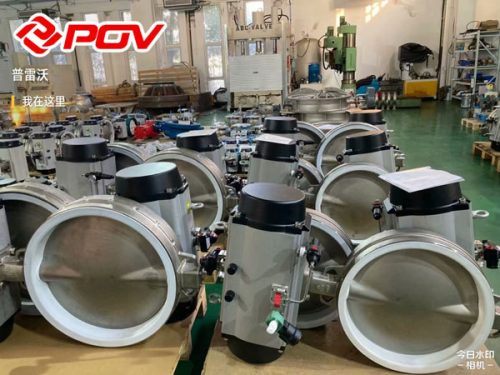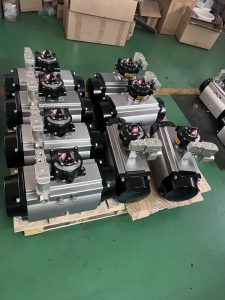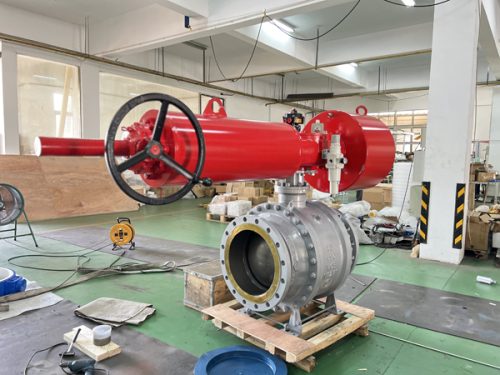Pneumatic solenoid valves are at the heart of modern control valve systems, offering precise actuation and control for a variety of industrial applications. From managing critical processes in manufacturing to ensuring safe and efficient operation in steam systems, the pneumatic solenoid valve plays an essential role. These valves are indispensable in control setups, such as the steam control valve, which optimizes steam flow and pressure. Paired with a steam flow control valve, they maintain consistent operation, even under fluctuating conditions. Additionally, devices like the steam pressure reducing valve and steam pressure regulating valve rely on pneumatic? valves to enhance accuracy and reliability. This guide explores their working principles, applications, and innovations shaping their future in industrial automation.
Introduction to Pneumatic Solenoid Valve Technology
Pneumatic solenoid valves are integral to enhancing the efficiency and precision of various industrial control systems. Their ability to provide rapid and reliable actuation makes them invaluable, particularly when paired with advanced components like pneumatic globe valves or pneumatic diaphragm control valves. These valves enable precise control of fluid and gas flow, ensuring optimal performance in demanding applications. Pressure regulating valve manufacturers often incorporate pneumatic solenoid valves to improve the performance of systems requiring consistent flow and pressure management. Additionally, their compatibility with temperature regulating valves ensures stability in processes where temperature-sensitive adjustments are critical.
Working Principles of Pneumatic Solenoid Valves
Functions: solenoid valves function as critical actuators in control systems, enabling precise and reliable fluid and gas flow regulation. Their operation relies on electromagnetic actuation, where an electrical signal activates the solenoid coil, shifting the valve to control air or fluid direction. These valves play a pivotal role in maintaining system efficiency by directing compressed air to open or close control valves, such as pneumatic globe valves or diaphragm valves. Their rapid switching abilities ensure seamless operations in dynamic industrial environments.
Key components: Pneumatic valves consist of several key components that ensure efficient and precise operation. These include the solenoid coil, which generates a magnetic field when electrified to activate the valve; the plunger, which moves to open or close the valve based on the solenoid’s action; and the valve body, which houses the internal components and accommodates specific flow paths. Additionally, seals and springs control fluid or air tightness and return the plunger to its default position when inactive. Integrated ports and orifices help regulate flow direction, while electrical connectors enable seamless integration into automated systems. Together, these components deliver reliable performance in industrial applications.
Advantages
Actuation mechanisms:? solenoid valves utilize electromagnetic actuation mechanisms to control the flow of fluids or gases efficiently. At their core, these mechanisms rely on a solenoid coil, which, when energized, generates a magnetic field to move a plunger or armature. This movement opens or closes internal passages within the valve, directing the flow through designated ports. The process is swift and precise, making these valves ideal for applications demanding rapid response times and reliability.
Energy efficiency:? solenoid valves are designed with energy efficiency in mind, ensuring optimal performance while minimizing power consumption. Their ability to provide precise flow control reduces unnecessary waste of air or fluid, thereby conserving energy in industrial systems. Advanced designs, such as low-power solenoid coils, require minimal electricity to generate the magnetic field for actuation. Additionally, their rapid switching capabilities and tight sealing functionality prevent leaks and ensure faster cycle times, further enhancing system efficiency.

Types of Pneumatic Solenoid Valves
Direct-acting:
Direct-acting solenoid valves are a core variant within the broader category of pneumatic solenoid valves, distinguished by their simple and reliable operation. Unlike pilot-operated valves, which rely on system pressure to assist in valve actuation, direct-acting valves operate independently of pressure, making them ideal for applications requiring precise control in low-pressure systems or vacuum environments. These valves function by directly lifting the valve seat through electromagnetic force, eliminating the need for additional pilot flow. This design ensures rapid response times and enhanced durability, particularly in industries such as medical equipment, instrumentation, and chemical processing.
Pilot-operated:
Pilot-operated solenoid valves are a vital category within solenoid valves, specifically designed for high-pressure applications that require efficient flow control. These valves utilize system pressure to assist in opening and closing the valve, allowing for the handling of larger flow rates with lower power consumption compared to direct-acting valves. The operation begins with the solenoid energizing a pilot valve, which then channels system pressure to actuate the main valve mechanism. This design makes pilot-operated valves exceptionally energy-efficient and reliable in applications involving high-pressure systems, such as industrial automation, oil and gas, and water treatment facilities.
Single-acting:
Single-acting solenoid valves are highly efficient components in the realm of pneumatic control, recognized for their straightforward operation and energy-saving design. Unlike double-acting valves, which require air pressure for both opening and closing actions, single-acting valves use air pressure to perform one movement while a spring mechanism returns the valve to its original position. This design simplifies the system, reduces air consumption, and enhances reliability by minimizing operational components.
Double-acting:
Double-acting solenoid valves are key components in advanced pneumatic systems, designed to deliver precise and flexible control in bidirectional operations. Unlike single-acting valves, which rely on air pressure for a single movement and a spring return for reset, double-acting valves use air pressure for both the opening and closing actions. This dual-pressure design allows for a balanced and consistent motion, making them ideal for applications requiring controlled force in both directions, such as robotics, aerospace actuators, and industrial automation.
Industrial Applications of Pneumatic Solenoid Valves
Oil: solenoid valves play a critical role in the oil industry, ensuring efficient and reliable control over fluid flow in various operations. From oil extraction to refining and transportation, these valves provide precise actuation and seamless integration into complex systems, managing high-pressure environments while maintaining safety and performance standards. Their ability to operate in hazardous and volatile conditions makes them indispensable for controlling the flow of crude oil, gas, and other fluids in pipelines, storage tanks, and separation units.
Gas: solenoid valves are indispensable in the gas industry, providing precise and reliable control over gas flow in extraction, processing, and distribution systems. These valves are engineered to handle the unique challenges of managing high-pressure gases, ensuring safety and operational efficiency in critical applications such as natural gas compression stations, processing plants, and distribution networks. Their rapid actuation and compatibility with automated control systems enable seamless integration into complex setups, enhancing both accuracy and responsiveness in gas flow management. Designed with materials resistant to corrosion and extreme temperatures, they ensure durability in demanding environments.

Chemical processing: solenoid valves are essential in chemical processing, where precision, safety, and reliability are paramount. These valves are designed to control and regulate the flow of liquids, gases, and aggressive chemicals used in production and handling processes. Their ability to withstand harsh environments, including exposure to corrosive substances and extreme temperatures, ensures long-lasting performance under demanding conditions. Integrated into automated systems, pneumatic solenoid valves enhance operational efficiency by providing precise flow control, rapid response times, and reduced manual intervention.
Manufacturing industries: valves are vital to manufacturing industries, where precision, efficiency, and automation are key drivers of success. These valves are widely used to regulate and control the flow of air, gases, and fluids in various manufacturing processes, enabling seamless operation of machinery and equipment. Integrated into automated systems, they enhance productivity by delivering precise actuation and minimizing downtime, making them indispensable for tasks such as assembly, material handling, and quality control.
Benefits of Using Pneumatic Solenoid Valves
Compact design: A compact design is a defining advantage of solenoid valves, offering unparalleled functionality and adaptability across a range of industrial applications. By minimizing their physical footprint, these valves save valuable space, making them ideal for installations in confined or complex system layouts. Their streamlined form not only reduces installation time but also simplifies maintenance, promoting operational efficiency. Despite their smaller size, compact solenoid valves maintain high performance levels, providing precise control and reliable operation.
Ease of integration: The ease of integration is a significant benefit of solenoid valves, making them a preferred choice for a wide range of industrial applications. Their compatibility with existing systems ensures seamless incorporation into established infrastructures, minimizing the need for extensive modifications. This adaptability not only reduces installation time but also lowers associated costs, allowing for faster operational deployment. solenoid valves are designed to function effectively in diverse environments, offering flexibility that accommodates various system requirements, from automated assembly lines to pressure control systems.
Rduced maintenance costs: solenoid valves significantly contribute to reduced maintenance costs through their durable and efficient design. Built with high-quality materials and engineered to withstand demanding industrial conditions, these valves deliver consistent performance while minimizing wear and tear. Their reliability reduces the frequency of equipment failures and the associated need for costly repairs or replacements, lowering overall operational expenses.
Maintenance and Troubleshooting for Pneumatic Solenoid Valves
Maintenance:
Routine maintenance of pneumatic solenoid valves is essential for preserving their performance and extending their operational life. Regular cleaning prevents the buildup of debris that can obstruct valve function, while periodic inspections help identify signs of wear or misalignment before they escalate into larger issues. Replacing worn components, such as seals or coils, ensures the valve operates with precision and prevents unnecessary downtime. Proper lubrication is also crucial to minimize friction and maximize efficiency.

Troubleshooting:
Effective troubleshooting of pneumatic solenoid valves is crucial for maintaining system integrity and reducing downtime. Common issues, such as leaks, irregular operation, or failure to actuate, often signal underlying problems like worn seals, dirt buildup, or electrical malfunctions. Diagnosing these issues begins with inspecting the valve for visible damage, ensuring proper supply pressure, and verifying electrical connections. Cleaning clogged components, tightening fittings, or replacing worn-out parts can quickly resolve many operational failures.
Future Trends and Innovations in Pneumatic Solenoid Valve
Future Trends: The future of pneumatic solenoid valves is being shaped by emerging technologies and groundbreaking innovations, driving significant advancements in industrial applications. Smart valve technology, with its ability to monitor and adjust operations in real-time, is revolutionizing system efficiency and reliability. Integration with IoT platforms enables remote diagnostics and predictive maintenance, minimizing downtime and operational disruptions. Improvements in materials, such as the use of lightweight composites and corrosion-resistant alloys, are enhancing durability and adaptability to extreme environments.
Innovations: Recent innovations in solenoid valves are transforming industrial operations by setting new benchmarks for efficiency and precision. Advanced control systems now enable more accurate modulation of airflow, resulting in improved process control and optimized system performance. Miniaturization has made these valves more compact, allowing for seamless integration into modern machinery with limited space constraints. Additionally, the adoption of advanced materials, such as high-strength polymers and corrosion-resistant alloys, has extended the durability and reliability of valves, even in harsh environments. These technological breakthroughs not only enhance functional versatility across various applications but also contribute to reducing overall operational costs, making solenoid valves a critical component in cutting-edge industrial solutions.

FAQ Pneumatic Solenoid Valve
Q1: What is the role of a pneumatic solenoid valve in systems utilizing self-operated pressure regulating valves?
A1: A pneumatic solenoid valve is essential in systems with self-operated pressure regulating valves as it controls the airflow that actuates the regulating mechanisms. By effectively managing pressure within the system, it ensures these valves maintain stable operation under varying conditions, enhancing overall system reliability and precision.
Q2: How do solenoid valves work in conjunction with self-operated control valves to improve efficiency?
A2: Pneumatic valves enable precise control of pneumatic systems, allowing self-operated control valves to adjust flow rates or pressures dynamically. This collaboration reduces energy consumption and ensures optimal performance, making the system adaptable for diverse industrial applications.
Q3: Can pneumatic valves be integrated with self-operated regulating valves in automated processes?
A3: Yes, solenoid valves can seamlessly integrate with self-operated regulating valves in automated processes. Their ability to control pneumatic actuation simplifies system design while offering enhanced responsiveness and reliability, ensuring minimal manual intervention and higher operational efficiency.
Conclusion Solenoid Valve
Pneumatic solenoid valves are integral to modern industrial systems, delivering exceptional precision and reliability. Their capability to regulate air flow seamlessly integrates with components like electric globe valves, pneumatic control valves, and electric control valves, ensuring optimal performance across diverse applications. Advances in materials, design, and smart technologies have enhanced their efficiency, reduced maintenance needs, and improved adaptability. Understanding their role and functionality underscores their critical contribution to creating sustainable and high-performing industrial control systems.

